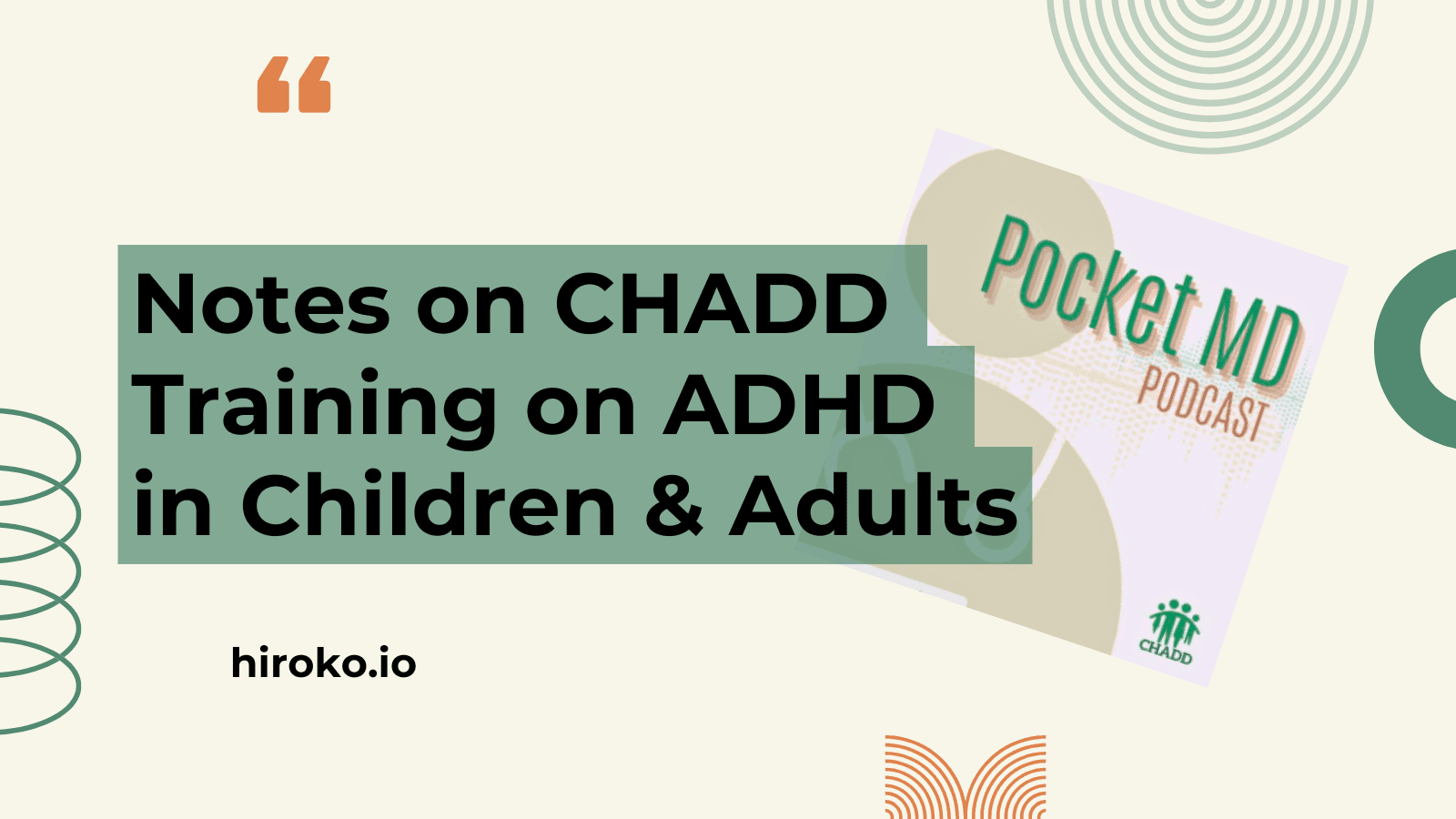This post summarizes the podcast titled “Recognition & Diagnosis of ADHD” in the series “Training on ADHD in Children and Adults” by Pocket MD. Pocket MD is a podcast hosted by CHADD (Children and Adults with Attention-Deficit/Hyperactivity Disorder).
“Recognition & Diagnosis of ADHD” (PD4457-040121AR)
What is ADHD (Attention Deficit Hyperactivity Disorder)?
- ADHD: neurodevelopmental disorder characterized by difficulties in regards to attention, hyperactivity, impulsivity, or any combination of those
- Inattention: failure to listen, short attention span for tasks, poor attention to detail (may result in errors on academic and other tasks), forgetting/losing things, lower tolerance for tasks that require effort
- Hyperactivity: restlessness, fidgetiness, difficulty remaining seated (“driven by a motor”)
- Impulsivity: difficulty waiting, taking turns, interrupting, intruding on other activities (“impatient”)
- Impulsivity and hyperactivity highly correlated
- Lifespan: decrease of ~25% of overall prevalence in adolescence
- ~60% are still experiencing some impairment in adulthood (maturity = fewer symptoms)
- For many years it was believed that ADHD spontaneously disappeared around adolescence
- At risk for limited higher education, un/under-employment, problems with inter-personal relationships (professional and personal)
- More likely to have comorbidity with anxiety (1/2) and depression (1/3); result of accrued negative feedback and failure experiences through lifetime
- Higher rates of alcohol and drug abuse
- Shorter life expectancy
- Cause: primarily genetic, but environmental factors play a part
- How parents respond to the child can have positive or negative impact on behavior manifestations, but parents do not “cause” ADHD
- Criticisms, over-control, and negative feedback can have negative impact
- Parent behavior training programs help support parents with effective strategies to help children better manage behavior
Impact on students’ functioning
- Academically: difficulty concentrating and completing seat work and homework, pay less attention to teacher
- Lower scores on standardized tests (“not working to potential”)
- Receive more negative feedback and penalties from teachers
- Socially and emotionally: issues with attention, self-control (impulsivity and hyperactivity) can have negative impact on relationships with peers
- Those with primary issue of inattention tend to be too quiet and withdrawn, which also impact social relationships with friends
- “Sluggish cognitive tempo”: appears withdrawn, doesn’t respond immediately, takes time to process information, has difficulty relating to others
Diagnosing ADHD
- Issues with attention, hyperactivity, and impulsivity must be exhibited at rate/frequency higher than for other kids of same gender and age
- Difficulties have persisted for at least 6 months (not just a response to change in environment/stressor)
- Symptoms of impairments before or at age 12
- Behaviors must manifest at both home and in school (work for adults), resulting in some impairment as a result in both environments
- These problems are not better explained by other difficulties or disabilities (like sensory issues, anxiety, learning disability)
- “Diagnosis of quantity, rather than quality”
Extra Notes on Diagnosing ADHD
- Diagnosing ADHD (CDC): there is no single test to diagnose ADHD
- DSM-5 Criteria for ADHD:
- For children up to 16 years, must have 6 or more symptoms of inattention and/or hyperactivity-impulsivity
- For ages 17 and older, must have 5 or more symptoms of inattention and/or hyperactivity-impulsivity
- NIH National Library of Medicine: Table 7 DSM-IV to DSM-5 Attention-Deficit/Hyperactivity Disorder Comparison
Manifestations of ADHD
- ADHD manifests in different ways, and it can be difficult for parents to determine if their children’s behaviors are due to ADHD or “typical behavior” for their age
- Can be recognized as early as preschool
- Early Childhood: difficulty sitting still, does not comply when asked to do or stop doing something, intrusive with other children’s space or aggressive
- Childhood: behaviors that affect academic and social behavior, issues with self-control, attention, and organization
- Adolescence: procrastination, difficulty managing materials and tasks, sleep deprivation, social issues
- Smarter children may not be diagnosed until later because they do not have to be fully attentive in order to learn
- Positive support may allow children to function well for longer
Want to read more of my summaries?
Main page on this blog that collects all of these summaries (and links to course content) is here:
